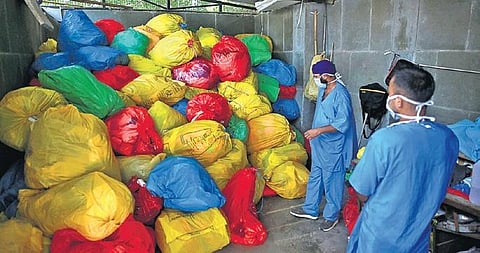

NEW DELHI: The two common bio-medical waste treatment facilities (CBWTF) in the city are grappling with increased load due to the COVID-19 pandemic, with their operators saying the pressure is set to increase with rising cases.
The two CBWTFs in Delhi are SMS Water Grace BMW Private Limited in Nilothi in west Delhi and Biotic Waste Solutions Private Limited in Jahangirpuri, with an operational capacity of 12 tonnes and 34 tonnes per day, respectively.
Together, these facilities have been disposing of around 19 tonnes of COVID-19 and 16 tonnes on non-COVID-19 bio-medical waste per day, according to their representatives.
SMS Water Grace collects COVID-19 bio-medical waste from government hospitals, including LNJP and Safdarjung Hospital, quarantine centres, isolation facilities, testing centres, dispensaries, private hospitals and laboratories in six districts of Delhi — west, southwest, central, Shahdara, east and northeast.
Biotic waste solutions covers north, northwest, New Delhi, south, and southeast districts. It collects COVID waste from AIIMS, Ram Manohar Lohia Hospital and Lady Hardinge Medical College etc. Municipal corporations are responsible for collecting COVID-19 bio-medical waste from houses of patients undergoing home quarantine.
This waste goes to the waste-to-energy plants, which have incinerators with large capacities. Delhi has three waste-to-energy treatment plants, at Sukhdev Vihar-Okhla, Narela-Bawana and Ghazipur. Amit Nilawar from SMS Water Grace said before the coronavirus, his facility had been operating at 50 percent capacity.
“Now, it is operating between 90 per cent and 110 per cent capacity due to the additional COVID-19 waste, which has increased the risk of shutdowns.” The incinerator is burning 13 tonnes of bio-medical waste (COVID and non-COVID)per day now against around six tonnes in the pre-coronavirus times. The machinery needs rest, he said. Nilawar said the operation cost per day has increased manifold because of the “tremendous pressure” on the facility.
(With PTI inputs)